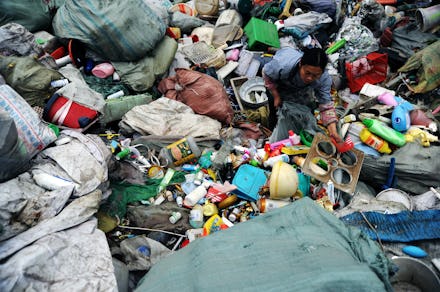China is no longer taking our trash. Now, Americans can expect heaping piles of displaced garbage.

Up until recently, your recycled waste was more well-traveled than the average American. That’s because millions of metric tons of throwaway plastics were packed onto boats and shipped to China every day. For years, China acted as the world’s trash can, taking in about half of the planet’s exported waste — but as of Jan. 1, those imports have been banned.
Now, America’s single-use water bottles, takeout coffee cups, straws and throwaway salad bowls are piling up with no place to go. An estimated 111 metric tons of plastic waste will be displaced throughout the world by 2030, a new study found — and that’s a serious problem.
“After 28 years of accepting all that plastic waste, it’s no wonder China says ‘no more,’” Amy Brooks, the study’s first author and a doctoral student at the University of Georgia’s New Materials Institute, said by phone. “It’s absolutely a wakeup call to the rest of the world to start managing their waste differently.”
The study, published in a journal called Science Advances on June 20, uses 10 years of import records into China to project the amount of displaced plastic, assuming waste production continues on its current trajectory. Much of that plastic is now expected to go to U.S. landfills or countries like Thailand, Malaysia and Vietnam. But an overwhelming surge of trash to other nations is still a problem for the United States, since it often ends up clogging oceans and disturbing ecosystems — or being burned and adding to the planet’s toxic air and global warming.
“The trend we found is that high-income, wealthy nations are the ones sending [waste] to the less-developed countries,” Brooks said. “We’re seeing a rapid growth in the amount of waste imports in Southeast Asia, and it’s questionable whether or not those nations will be able to handle it. A lot of those nations’ waste is rapidly growing amongst themselves, and their waste management infrastructure might be behind.”
In the 1990s, China saw an emerging market for plastic production and thought that taking in the world’s garbage would help make use of some extra materials. Meanwhile, the U.S. and other wealthy countries found it was cheaper to ship their junk abroad than to drive it around and process it domestically. As a result, plastic waste imports and exports grew by more than 800% worldwide between 1993 and 2016, the study found.
However, the low quality of imported plastics often made other countries’ garbage unusable. China’s new law banning waste imports — called the “national sword” policy — was also at least partially triggered by public outrage. A 2016 documentary called Plastic China sparked public outrage over the nation’s waste control industry, despite later being erased from China’s internet. The images are brutal and almost post-apocalyptic: entire families sorting through trash in wasteland-like dumping grounds, children using dirty water to wash their hair, thick clouds of smoke coming from burning trash and hungry people looking through a contaminated river for dead fish to eat.
It’s a grim glimpse into other nations’ possible futures. And as China’s national sword falls on the United States, Americans might want to consider how they can get their massive waste problem under control.
“One of my favorite findings in this paper is that 89% of all exports have been polymers of plastic that are used in single-use plastic items, like water bottles, food wrappers, that kind of thing,” Brooks said. “That screams to me that this is an easy problem to tackle. If someone in the U.S. can make the choice to use a reusable water bottle or grocery bag, or say ‘no’ to plastic usage, then that can help.
“I know it may not feel like an individual can make a difference, but it starts there. When millions of people start doing it, it can have a huge impact.”